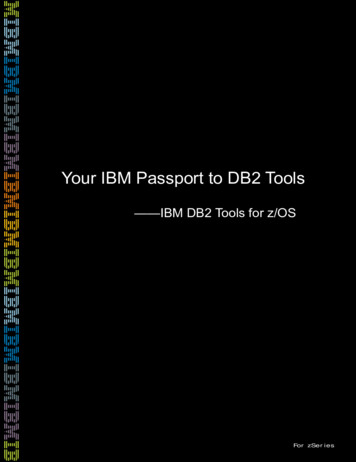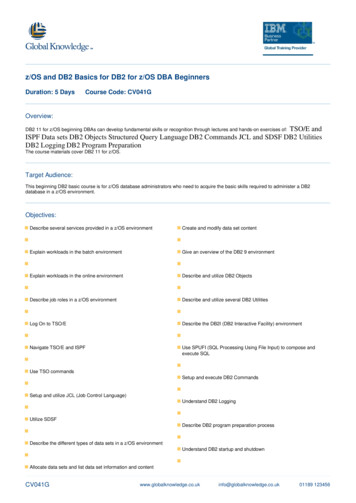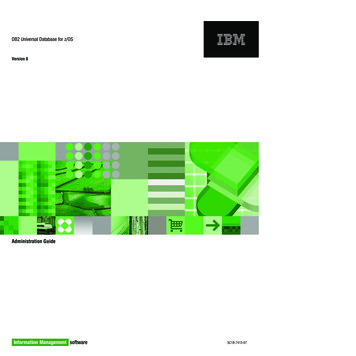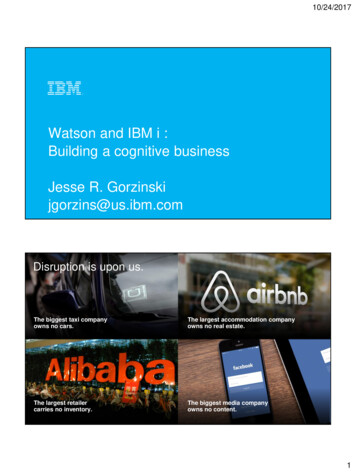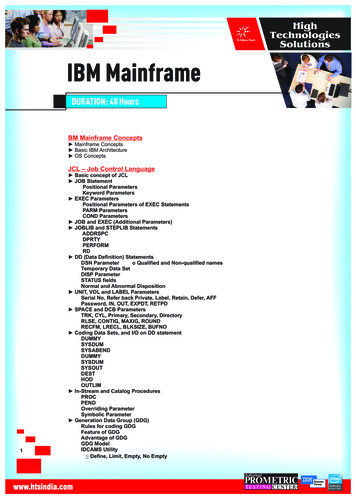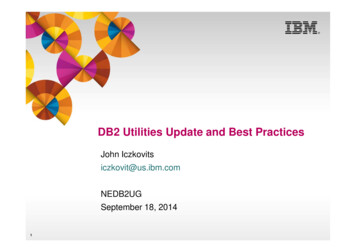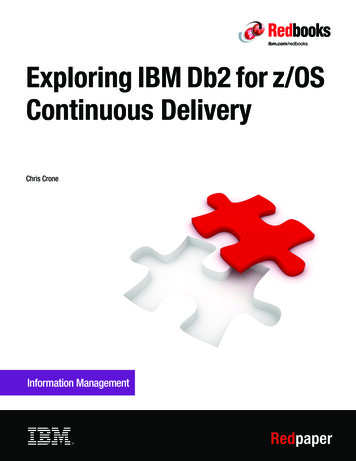
Transcription
Front coverExploring IBM Db2 for z/OSContinuous DeliveryChris CroneRedpaper
International Technical Support OrganizationExploring IBM Db2 for z/OS Continuous DeliveryMarch 2018REDP-5469-00
Note: Before using this information and the product it supports, read the information in “Notices” on page v.First Edition (March 2018)This edition applies to Version 12, Release 1, Modification 00 of Db2 12 for z/OS (5650-DB2).This document was created or updated on March 21, 2018. Copyright International Business Machines Corporation 2018. All rights reserved.Note to U.S. Government Users Restricted Rights -- Use, duplication or disclosure restricted by GSA ADP ScheduleContract with IBM Corp.
ContentsNotices . . . . . . . . . . . . . . . . . . . . . . . . . . . . . . . . . . . . . . . . . . . . . . . . . . . . . . . . . . . . . . . . . .vTrademarks . . . . . . . . . . . . . . . . . . . . . . . . . . . . . . . . . . . . . . . . . . . . . . . . . . . . . . . . . . . . . . viPreface . . . . . . . . . . . . . . . . . . . . . . . . . . . . . . . . . . . . . . . . . . . . . . . . . . . . . . . . . . . . . . . . . viiAuthors . . . . . . . . . . . . . . . . . . . . . . . . . . . . . . . . . . . . . . . . . . . . . . . . . . . . . . . . . . . . . . . . . . viiNow you can become a published author, too! . . . . . . . . . . . . . . . . . . . . . . . . . . . . . . . . . . . viiComments welcome. . . . . . . . . . . . . . . . . . . . . . . . . . . . . . . . . . . . . . . . . . . . . . . . . . . . . . . viiiStay connected to IBM Redbooks . . . . . . . . . . . . . . . . . . . . . . . . . . . . . . . . . . . . . . . . . . . . viiiChapter 1. Continuous delivery for Db2 12 for z/OS . . . . . . . . . . . . . . . . . . . . . . . . . . . . 11.1 Why continuous delivery . . . . . . . . . . . . . . . . . . . . . . . . . . . . . . . . . . . . . . . . . . . . . . . . . 21.1.1 Proposals for implementing continuous delivery. . . . . . . . . . . . . . . . . . . . . . . . . . . 31.1.2 The strategy . . . . . . . . . . . . . . . . . . . . . . . . . . . . . . . . . . . . . . . . . . . . . . . . . . . . . . 31.2 Migration from Db2 11 to Db2 12 . . . . . . . . . . . . . . . . . . . . . . . . . . . . . . . . . . . . . . . . . . 61.2.1 Function levels . . . . . . . . . . . . . . . . . . . . . . . . . . . . . . . . . . . . . . . . . . . . . . . . . . . . 71.2.2 Relationship between code levels and function levels . . . . . . . . . . . . . . . . . . . . . 111.2.3 Relationship between a function level and APPLCOMPAT . . . . . . . . . . . . . . . . . 111.2.4 Catalog levels . . . . . . . . . . . . . . . . . . . . . . . . . . . . . . . . . . . . . . . . . . . . . . . . . . . . 121.2.5 Migrating Db2 11 data sharing groups to Db2 12 . . . . . . . . . . . . . . . . . . . . . . . . . 131.3 New function activation beyond base Db2 12 capability . . . . . . . . . . . . . . . . . . . . . . . . 141.3.1 Activate new function without catalog changes. . . . . . . . . . . . . . . . . . . . . . . . . . . 141.3.2 Activate new function with catalog changes . . . . . . . . . . . . . . . . . . . . . . . . . . . . . 151.3.3 Activate new function with catalog change while skipping function levels . . . . . . 161.3.4 Function activation of previous level (* mode) . . . . . . . . . . . . . . . . . . . . . . . . . . . 171.3.5 SYSLIB.SYSLEVELUPDATES table . . . . . . . . . . . . . . . . . . . . . . . . . . . . . . . . . . 191.3.6 Additional table changes . . . . . . . . . . . . . . . . . . . . . . . . . . . . . . . . . . . . . . . . . . . . 201.4 DISPLAY GROUP command . . . . . . . . . . . . . . . . . . . . . . . . . . . . . . . . . . . . . . . . . . . . 211.4.1 DISPLAY GROUP (coexistence): From Db2 12 member . . . . . . . . . . . . . . . . . . . 221.4.2 DISPLAY GROUP (new function not available) . . . . . . . . . . . . . . . . . . . . . . . . . . 231.4.3 DISPLAY GROUP (New Function Active). . . . . . . . . . . . . . . . . . . . . . . . . . . . . . . 241.4.4 DISPLAY GROUP (after CATMAINT). . . . . . . . . . . . . . . . . . . . . . . . . . . . . . . . . . 241.5 Function level adoption preferred practices . . . . . . . . . . . . . . . . . . . . . . . . . . . . . . . . . 251.6 APPLCOMPAT adoption preferred practices . . . . . . . . . . . . . . . . . . . . . . . . . . . . . . . . 25Chapter 2. Changes in Db2 12 affecting applications and more . . . . . . . . . . . . . . . . .2.1 Application considerations . . . . . . . . . . . . . . . . . . . . . . . . . . . . . . . . . . . . . . . . . . . . . .2.1.1 The behavior of SQL, DDL, and DCL in Db2 12 . . . . . . . . . . . . . . . . . . . . . . . . . .2.1.2 Dynamic SQL, DDL, and DCL. . . . . . . . . . . . . . . . . . . . . . . . . . . . . . . . . . . . . . . .2.2 New built-in global variables . . . . . . . . . . . . . . . . . . . . . . . . . . . . . . . . . . . . . . . . . . . . .2.2.1 PRODUCTID EXT . . . . . . . . . . . . . . . . . . . . . . . . . . . . . . . . . . . . . . . . . . . . . . . .2.2.2 CATALOG LEVEL . . . . . . . . . . . . . . . . . . . . . . . . . . . . . . . . . . . . . . . . . . . . . . . .2.2.3 DEFAULT SQLLEVEL . . . . . . . . . . . . . . . . . . . . . . . . . . . . . . . . . . . . . . . . . . . . .2.3 The IBM Data Server Driver . . . . . . . . . . . . . . . . . . . . . . . . . . . . . . . . . . . . . . . . . . . . .2.3.1 The ClientApplCompat keyword . . . . . . . . . . . . . . . . . . . . . . . . . . . . . . . . . . . . . .2.3.2 What the clients see after Connect . . . . . . . . . . . . . . . . . . . . . . . . . . . . . . . . . . . .2.3.3 SQLCA and GET DIAGNOSTIC impacts . . . . . . . . . . . . . . . . . . . . . . . . . . . . . . .2.3.4 DDF commands and messages . . . . . . . . . . . . . . . . . . . . . . . . . . . . . . . . . . . . . .27282930313131323232363637Chapter 3. Db2 12 documentation: Information in a new way . . . . . . . . . . . . . . . . . . . 39 Copyright IBM Corp. 2018. All rights reserved.iii
Chapter 4. Final thoughts on continuous delivery. . . . . . . . . . . . . . . . . . . . . . . . . . . . . 47Related publications . . . . . . . . . . . . . . . . . . . . . . . . . . . . . . . . . . . . . . . . . . . . . . . . . . . . .IBM Redbooks . . . . . . . . . . . . . . . . . . . . . . . . . . . . . . . . . . . . . . . . . . . . . . . . . . . . . . . . . . .Online resources . . . . . . . . . . . . . . . . . . . . . . . . . . . . . . . . . . . . . . . . . . . . . . . . . . . . . . . . .Help from IBM . . . . . . . . . . . . . . . . . . . . . . . . . . . . . . . . . . . . . . . . . . . . . . . . . . . . . . . . . . .ivExploring IBM Db2 for z/OS Continuous Delivery49494949
NoticesThis information was developed for products and services offered in the US. This material might be availablefrom IBM in other languages. However, you may be required to own a copy of the product or product version inthat language in order to access it.IBM may not offer the products, services, or features discussed in this document in other countries. Consultyour local IBM representative for information on the products and services currently available in your area. Anyreference to an IBM product, program, or service is not intended to state or imply that only that IBM product,program, or service may be used. Any functionally equivalent product, program, or service that does notinfringe any IBM intellectual property right may be used instead. However, it is the user’s responsibility toevaluate and verify the operation of any non-IBM product, program, or service.IBM may have patents or pending patent applications covering subject matter described in this document. Thefurnishing of this document does not grant you any license to these patents. You can send license inquiries, inwriting, to:IBM Director of Licensing, IBM Corporation, North Castle Drive, MD-NC119, Armonk, NY 10504-1785, USINTERNATIONAL BUSINESS MACHINES CORPORATION PROVIDES THIS PUBLICATION “AS IS”WITHOUT WARRANTY OF ANY KIND, EITHER EXPRESS OR IMPLIED, INCLUDING, BUT NOT LIMITEDTO, THE IMPLIED WARRANTIES OF NON-INFRINGEMENT, MERCHANTABILITY OR FITNESS FOR APARTICULAR PURPOSE. Some jurisdictions do not allow disclaimer of express or implied warranties incertain transactions, therefore, this statement may not apply to you.This information could include technical inaccuracies or typographical errors. Changes are periodically madeto the information herein; these changes will be incorporated in new editions of the publication. IBM may makeimprovements and/or changes in the product(s) and/or the program(s) described in this publication at any timewithout notice.Any references in this information to non-IBM websites are provided for convenience only and do not in anymanner serve as an endorsement of those websites. The materials at those websites are not part of thematerials for this IBM product and use of those websites is at your own risk.IBM may use or distribute any of the information you provide in any way it believes appropriate withoutincurring any obligation to you.The performance data and client examples cited are presented for illustrative purposes only. Actualperformance results may vary depending on specific configurations and operating conditions.Information concerning non-IBM products was obtained from the suppliers of those products, their publishedannouncements or other publicly available sources. IBM has not tested those products and cannot confirm theaccuracy of performance, compatibility or any other claims related to non-IBM products. Questions on thecapabilities of non-IBM products should be addressed to the suppliers of those products.Statements regarding IBM’s future direction or intent are subject to change or withdrawal without notice, andrepresent goals and objectives only.This information contains examples of data and reports used in daily business operations. To illustrate themas completely as possible, the examples include the names of individuals, companies, brands, and products.All of these names are fictitious and any similarity to actual people or business enterprises is entirelycoincidental.COPYRIGHT LICENSE:This information contains sample application programs in source language, which illustrate programmingtechniques on various operating platforms. You may copy, modify, and distribute these sample programs inany form without payment to IBM, for the purposes of developing, using, marketing or distributing applicationprograms conforming to the application programming interface for the operating platform for which the sampleprograms are written. These examples have not been thoroughly tested under all conditions. IBM, therefore,cannot guarantee or imply reliability, serviceability, or function of these programs. The sample programs areprovided “AS IS”, without warranty of any kind. IBM shall not be liable for any damages arising out of your useof the sample programs. Copyright IBM Corp. 2018. All rights reserved.v
TrademarksIBM, the IBM logo, and ibm.com are trademarks or registered trademarks of International Business MachinesCorporation, registered in many jurisdictions worldwide. Other product and service names might betrademarks of IBM or other companies. A current list of IBM trademarks is available on the web at “Copyrightand trademark information” at http://www.ibm.com/legal/copytrade.shtmlThe following terms are trademarks or registered trademarks of International Business Machines Corporation,and might also be trademarks or registered trademarks in other countries.CICS Db2 DB2 IBM IBM z IMS Redbooks Redpaper Redbooks (logo)z/OS The following terms are trademarks of other companies:Linux is a trademark of Linus Torvalds in the United States, other countries, or both.Windows, and the Windows logo are trademarks of Microsoft Corporation in the United States, othercountries, or both.Java, and all Java-based trademarks and logos are trademarks or registered trademarks of Oracle and/or itsaffiliates.UNIX is a registered trademark of The Open Group in the United States and other countries.Other company, product, or service names may be trademarks or service marks of others.viExploring IBM Db2 for z/OS Continuous Delivery
PrefaceThis IBM Redpaper publication provides key information about continuous delivery in IBMDb2 12 for z/OS . It discusses how continuous delivery works and the changes that havebeen made in Db2 12 to support continuous delivery, such as adding a new catalog table andchanging existing catalog tables. Also the paper covers the effects on applications and how totake advantage of new function provided using the continuous delivery model.AuthorsThis paper was produced with the International Technical Support Organization, RaleighCenter.Chris Crone is an IBM Distinguished Engineer and the team lead for the Relational DatabaseService (RDS) Execution Engine area in IBM Db2 for z/OS. Chris has worked on Db2 forz/OS for over 28 years. He has contributed to many initiatives in Db2, such as storedprocedures, user-defined functions, and multiple-row insert and fetch. Chris works frequentlywith customers and independent software vendors (ISVs) on building and porting applicationsto Db2.Thanks to the following people for their contributions to this project:Martin Keen, LindaMay PattersonInternational Technical Support Organization, Raleigh CenterJohn CampbellIBM Distinguished EngineerPaul McWilliamsAdvisory Technical Writer, Db2 for z/OS and Db2 ToolsNow you can become a published author, too!Here’s an opportunity to spotlight your skills, grow your career, and become a publishedauthor—all at the same time! Join an ITSO residency project and help write a book in yourarea of expertise, while honing your experience using leading-edge technologies. Your effortswill help to increase product acceptance and customer satisfaction, as you expand yournetwork of technical contacts and relationships. Residencies run from two to six weeks inlength, and you can participate either in person or as a remote resident working from yourhome base.Find out more about the residency program, browse the residency index, and apply online at:ibm.com/redbooks/residencies.html Copyright IBM Corp. 2018. All rights reserved.vii
Comments welcomeYour comments are important to us!We want our papers to be as helpful as possible. Send us your comments about this paper orother IBM Redbooks publications in one of the following ways: Use the online Contact us review Redbooks form found at:ibm.com/redbooks Send your comments in an email to:redbooks@us.ibm.com Mail your comments to:IBM Corporation, International Technical Support OrganizationDept. HYTD Mail Station P0992455 South RoadPoughkeepsie, NY 12601-5400Stay connected to IBM Redbooks Find us on Facebook:http://www.facebook.com/IBMRedbooks Follow us on Twitter:http://twitter.com/ibmredbooks Look for us on LinkedIn:http://www.linkedin.com/groups?home &gid 2130806 Explore new Redbooks publications, residencies, and workshops with the IBM Redbooksweekly sf/subscribe?OpenForm Stay current on recent Redbooks publications with RSS oring IBM Db2 for z/OS Continuous Delivery
1Chapter 1.Continuous delivery for Db2 12for z/OSDb2 12 for z/OS delivers the infrastructure to support continuous delivery. With continuousdelivery, Db2 ships new function, preventive service, and prescriptive service in the sameservice.This chapter provides an overview of the continuous delivery function and includes thefollowing topics: Why continuous deliveryMigration from Db2 11 to Db2 12New function activation beyond base Db2 12 capabilityDISPLAY GROUP commandFunction level adoption preferred practicesAPPLCOMPAT adoption preferred practices Copyright IBM Corp. 2018. All rights reserved.1
1.1 Why continuous deliveryIBM Db2 12 for z/OS has many new innovations that increase Db2 availability, reliability,scalability, and security for business critical information. It offers performance and functionalimprovements for both transactional and analytical workloads and makes installation andmigration simpler and faster. It also allows you to develop applications for the cloud andmobile devices by providing self-provisioning, multitenancy, and self-managing capabilities inan agile development environment.With Db2 12 and its support for the continuous delivery function, preventive service, andprescriptive service ship in the same stream. IBM has used this approach before; in fact, Db2always shipped some new function in the service stream. Two examples of this approach are: Db2 10 introduced support for IBM Db2 Analytics Accelerator support in the servicestream. Db2 11 provided JavaScript Object Notation (JSON) support and native RESTful serviceAPIs in the service stream.What is new is that IBM announced its intention to deliver significant, mainline enhancementsin the service stream. In the past, Db2 development generally tried to limit enhancements inthe service stream to periphery features when possible. This approach balanced the need tobring new function to market and maintain product stability.To stay competitive, enterprises are frequently demanding that applications support newfunction and capabilities in days, not months or years. This requirement makes access to thelatest Db2 functions and features vital. The question of how to best address this requirementwas the subject of much discussion between Db2 development and customers.Prior to Db2 12, the status quo for releases was as follows: The Db2 development team produced new releases approximately every 3 years, butcustomer adoption of these new releases was longer than 3 years. This adoption lag timecaused customers to be a whole release behind after a few releases. Because customerswere not in sync on which releases they had adopted, the Db2 team was asked to supportskip release migration for literally every release. Although the Db2 team recognized theneed for skip release migration, it was not necessarily in the best interest of Db2 orcustomers for customers to remain two releases back level. Therefore, skip releasemigrations were supported roughly only once every 10 years. In every version the Db2 development team retrofitted a limited number of new features inthe service stream, which were primarily urgent and generally low risk features. Thisapproach forced many customers to wait for needed features. Customers saw deployment of new releases as disruptive, making them reluctant to moveto a new release, which inhibited their ability to take advantage of new features. Many customers wanted new features delivered much faster. Industry and customer trends are moving away from monolithic code delivery toward acontinuous delivery model.2Exploring IBM Db2 for z/OS Continuous Delivery
1.1.1 Proposals for implementing continuous deliveryThe Db2 team reviewed the following proposals for continuous delivery with customers: Support a faster release cycle with new Db2 releases every 18 months.– Customers were not able to take on such a fast migration due to the cost of any versionor release migration.– The migration effort would be just as large as moving to a new Db2 version.– A new version or release is a new function modification identifier (FMID), ordering anew FMID requires justification, a project plan, and funding in most customer shops.– Even with the promise of skip release migration and no catalog changes in the vNextrelease, the concept was still unacceptable. Support continuous release cycles with each release (such as, Db2 12.1, 12.2, and 12.3)where the customer orders Db2 12 and gets the current point release that is available atthat time. For example, if a customer ordered Db2 12 3 years after general availability(GA), the customer gets Db2 12.x, where x is the release level that was current at thattime.Customer also did not accept this approach because it generated considerable migrationand coexistence challenges and a high cost of maintenance (forward fits) for the Db2development organization. Support a combination of service only (sometimes referred to as a maintenance only orstable release) and new function release streams. Although many other products arepursuing this path, in a Db2 data sharing group, all members must be at the same level touse a new function. So, a V12.1.1 stable release version of Db2 cannot coexist with aV12.4.1 new function release Db2, and if they did, capability is limited to the V12.1.1release. Integration of a new function release with a stable function release is just a newmigration, which was also not acceptable.Ultimately continuous delivery of a single stream was determined to be the best way to delivernew function. The feedback from customers was clear. Integration of new function in theservice stream is the best strategy, if adoption of function can be controlled by the customerand if applying maintenance will not require activation of new function.1.1.2 The strategyThe starting point for continuous delivery was GA of Db2 12. Starting with Db2 12, customerswill see a significantly higher number of new function APARs that deliver new capability in theservice stream. There is a single maintenance stream for Db2 12, which includes correctiveservice, preventative service, and PTFs that are used to enable new function.This approach allows customers to adopt new function in small, consumable units at a pacethey are comfortable with. A new release can be a big effort for our customers. Db2introduces function levels and extends application compatibility (referred to asAPPLCOMPAT hereafter) to support function levels.APPLCOMPAT can be used to test and deploy applications at a specific function level and tostabilize the functional environment for that application, while still allowing other applicationsto take advantage of recently introduced features that are provided by higher-level functionlevels. This approach enables customers to establish islands of stability for applications.With continuous delivery, customers can run Db2 code that is capable of doing things thathave not been adopted yet. By running the “maintenance” that supports a function level,before adopting that function level (using the -ACTIVATE command), customers can ensureChapter 1. Continuous delivery for Db2 12 for z/OS3
that the code level is solid before adopting the function level that the code supports.Activating a function level does not do anything other than allow you to use the new function.Applications remain stable because their behavior is controlled by APPLCOMPAT, not by afunction level.The Db2 team expects that point releases will be a rare exception. However, there aresituations when a new point release or a new version might be necessary. For example,occasionally Db2 adopts a new compiler, which can cause the recompilation of large portionsof the product code. Recompiling the product is not something that makes sense to do in themaintenance stream (one or more APARs), because that can create a maintenance level setthat makes it difficult to apply a needed APAR in a situation where a fix is needed outside of anormal maintenance cycle. Another example is the need to prerequisite a new IBM z Systems architecture level or z/OS version. Such prerequisites are usually associated witharchitectural changes that affect significant portions of the product and, as such, are probablybetter introduced at a version or release boundary.As part of continuous delivery, Db2 development is committed to maintaining production levelquality in the service stream. Db2 development understands the need for system stability andavailability. The Db2 team is going to control the input to development in terms of the size andrisk of the items to be delivered under continuous delivery. Any new function produced will notblock the teams’ ability to deliver service. There is an increased focus on functional andperformance regression testing in support of the maintenance stream. New function isdelivered when the quality is correct and the item is completely tested, not based on adelivery date. Items not included in Db2 12, new initiatives, and request for enhancements(RFEs) are candidates for future delivery. As always, an item can be in the backlog, without acommitment to deliver that item; however, that simply means the item has enough merit to beconsidered.The Db2 internal resource lock manager (IRLM) is both a separate subsystem and an integralcomponent of Db2. IRLM works with Db2 to ensure data integrity through serialization. IRLMhas been using a continuous delivery strategy for many years, so there are no changes toIRLM.Continuous delivery in Db2 12 solves customer issues concerning moving to a new release inthe following ways: Reduce the time to adopt new functionalityCustomers can run with the Db2 code that contains the new function as part of theirnormal maintenance process. By doing this, the customer is assured that the code thatsupports the function level does not regress existing applications. After a function level isactivated, only those applications that need the new function are exposed to that functionvia APPLCOMPAT. Customers are more likely to have the function that they need alreadyinstalled on their systems when they need it for an application. All they need to do isactivate it. Increases the time between versionsThis approach drives the delivery of more IT organization value because less time andeffort is spent on migrating to new versions of Db2.Strategy for SMP/ECompanies handle management of SMP/E for z/OS environments for the Db2 run timedifferently, so one size does not fit all. In general, they Receive and Apply maintenance, but donot Accept the maintenance until they are ready to start the next maintenance cycle. Thisapproach allows the customer to reject any maintenance that might be causing a problem.4Exploring IBM Db2 for z/OS Continuous Delivery
At the start of the next maintenance cycle, the customer Accepts the previous maintenanceand starts over with a new Receive and Apply cycle. Given this paradigm, it is reasonable toassume that most customers will not activate a function level until they have done an Accepton that maintenance. For example, if a customer does two maintenance cycles a year, thisequates to a lag of about 6 months between the time that maintenance is applied and the timethat a customer considers activating that function level. Of course, function can be madeavailable in development environments in a more aggressive manner, if specific capabilitiesare needed for a development project.Note: There are no changes to consolidated service test (CST) and recommended serviceupgrades (RSUs) done on IBM Db2 maintenance streams. These changes are done afterDb2 ships the maintenance release. Both CST and RSU continues as before.Design ThinkingThe Db2 development team is complementing their continuous delivery model by adoptingthe Design Thinking methodology. A key component to Design Thinking is sponsor users. Forexample, a group of sponsor users who want a new function are involved early in thedevelopment process to make sure development gets the design correct and that this newfunction is readily consumable. Development wants to deliver a function that is easy to adoptand that customers truly believe in. If there are no sponsor users for a particular function,there will be no development of that function.Traditionally, development has worked with a small number of customers in the early supportprogram (ESP). In the ESP, customers were involved in validation of what was built. WithDesign Thinking, the sponsor users are involved when the items are being designed toensure that the item is designed correctly and is readily consumable. Customer input in thefuture is going to be much more targeted than what it was in the ESPs. The Db2 developmentteam has a stronger focus on getting the design correct up front.ISV considerationIndependent software vendors (ISVs), whether they are tool vendors or application vendors,are an important part of the Db2 and IBM Z ecosystem. The Db2 development team realizesthe dependency that customers have on ISV products as part of their Db2 environment.Because of these dependencies, the Db2 development team runs a vendor program thatprovides detailed information about changes and future plans to all vendors on an equalbasis. All vendors, including IBM program products, receive the same information aboutupcoming changes at the same time. Typically, this occurs early in the development process,regardless of whether the change is shipped as part of a new version or as part of anenhancement in the field via an APAR.For typical version upgrades, the vendor program includes both early and regularcommunication updates as well as early access to the code. ISV code drops of the newrelease usually start about a year prior to the ESP start.The Db2 development team also maintains a list of ISV contacts and a list of specific APIs,modules, or control structures that ISVs are sensitive to. ISVs receive automated updateswith notification of APARs affecting interfaces an ISV indicates they are sensitive to. Regularsharing of documentation for design changes delivered in a maintenance stream is done priorto shipping those changes.Chapter 1. Continuous delivery for Db2 12 for z/OS5
ISV continuous delivery support summaryThe overriding aim of the Db2 development team is to ensure the stability of customerenvironments. To help achieve this goal the Db2 development team commits to increasedsupport for ISVs in the following ways: Improved, earlier communication of changesEarly access to new maintenanceMore consistent and timely update of serviceability informationPeriodic longer view updatesOngoing use of improved communication channels between ISVs and Db2 developmentIn general, information about a new function in a given function level is made available whenthat function level ships. However, ISVs h
Db2 12 for z/OS . It discusses how continuous delivery works and the changes that have been made in Db2 12 to support continuous delivery, such as adding a new catalog table and changing existing catalog tables. Also the paper covers the effects on applications and how to take advantage of new function provided using the continuous delivery .
